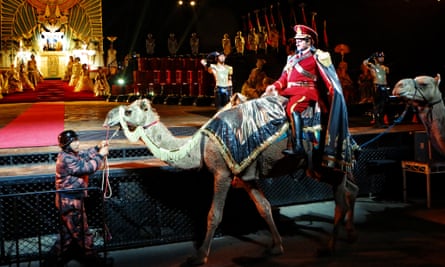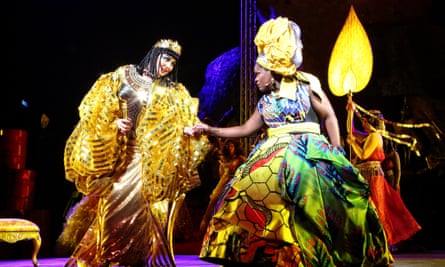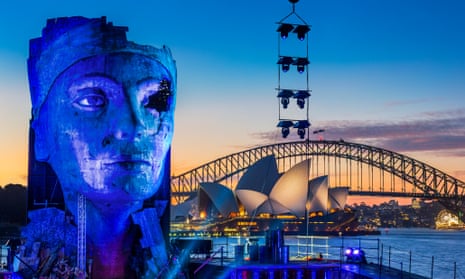It’s Friday morning and I’m running late even before I remember I’ve forgotten to check the dress code for Opera Australia’s gala opening of Aida tonight. Please, please let it not be too smart. I click the email invitation. Red carpet. Black tie. I shouldn’t be surprised, of course. This isn’t any old night out. It’s Handa Opera on Sydney Harbour, one of the biggest spectacles in the city’s arts calendar.
I text my colleague who’s coming as my plus one – “Silly opera! Any chance you’ve brought a dinner jacket into work today?” – but I accidentally send it to my father in the UK, who happens to work in classical music. Damn it. “Black tie?” he pings back. “The sort of thing that gives opera a bad name! And I’m afraid Aida can be quite a silly opera too.”
Love you, pa. While (like him) I’m a big Verdi fan, I’ve never actually seen the composer’s epic tale of Egyptian and Ethiopian love and war. I do know it usually features a massive head. And that my colleague has never seen any opera before. I also know that Opera on Sydney Harbour is a HUGE deal.
When I moved to Sydney last July, it was top of my to-do list. So here I am. Sipping champagne as I drink in the view that Clive James prepped me to love long before I lived here: the CBD skyline; the floodlit sails of the Opera House; the distant silhouette of the bridge. And a massive head.
It really is impressive – 18m tall and 15 tonnes with one whole eye gouged out. More than 700 people were involved in this production before a note was even heard. Lines of Shelley repeat on me. “My name is Ozymandias, king of kings: Look on my works, ye Mighty, and despair!”
Closer to eye level, there’s a second head, set with two deep brown eyes. The camel, standing by the VIP bar, seems composed in the face of the human penguins taking selfies with him, not to mention his impending cameo in the show. He’s not the only one.

Over the next two-and-a-half hours, tribe after tribe troop on to the giant platform moored at Mrs Macquairies Point. First come the PVC-clad bikers. Then the Mussolini-era soldiers. The jackal-headed dancers. The extras from The Da Vinci Code. And the Egyptian fancy-dress party: mezzo-soprano Milijana Nikolic is channelling Elizabeth Taylor by way of Kings Cross.
As to plot, Egyptian warrior Radamès (Walter Fraccaro) loves warring and women, namely Aida (Latonia Moore), an Ethiopian slave. Aida loves him back but if you think that’s that, you’ve not seen any opera either. Princess Amneris (Nikolic) loves Radamès, too, and knows she has a rival. What she doesn’t realise is that Aida is also a princess whose father, King Amonasro (Michael Honeyman), is determined to set his daughter free. By invading Egypt. Love you, pa.
The aria setting up this love triangle – Amneris, Radamès and Aida’s Vieni, o diletta, appressati (“Come, O delight, come closer”) – is a total stunner and my novice neighbour is getting properly into it: “That song was brilliant!” There’s jolly good singing from the Opera Australia chorus too, even if the alfresco acoustics demand everyone is miked up, which throws the singers’ voices around like a ventriloquist. I also miss being able to spy on the conductor (Brian Castles-Onion) who is hidden away with his orchestra.

One great thing about opera, though, is even when you don’t think you’ve heard any, you probably have. So it is with Verdi’s Triumphal March for my friend. Why director Gale Edwards and her design team feel the need to chuck a small arts company’s annual budget at the scene is less clear. Between the camels, the coffins, the gold lamé and a routine worthy of Strictly Come Dancing, no rhinestone is left unturned.
Maybe, like my dad says, it’s just this opera. After all, there’s not a whole lot going on in Aida’s libretto beyond “I love him”, “She loves him”, “I love her”, “Let’s all worship the goddess”. Or maybe it’s me. My tastes lean towards the small-scale drama – think La bohème’s freezing flatmates – not the ball-busting blockbuster.
At any rate, a friend who saw a preview warned me that following the first-half fireworks, the second half drags a bit. I disagree. Post-interval, the show has fewer pyrotechnics, more heart and – crucially – more Moore, who is radiant of voice and noble of presence as Aida. I could have done without the huge hydraulic arch that blocked our view for some of the finale, but as Aida and Radamès approach their asphyxiated end, the production, ironically, is finally given room to breathe.
It’s great that Opera on Sydney Harbour has become a must-see – and for more than the regular opera crowd. It can’t fail with that backdrop. But I’m not sure it’s a true showcase of the art form at a time when opera doesn’t just need new audiences, but needs to keep them too. “Round the decay/ Of that colossal wreck, boundless and bare/ The lone and level sands stretch far away.”
The applause, when it comes, is muted and, after a final curtain call, the crowds troop back up the tiered seating to catch their shuttle buses. Several elderly opera-goers struggle in the scrum to get out. As one of them says: “It’s all a bit much when you’ve just watched someone buried alive.”

Comments (…)
Sign in or create your Guardian account to join the discussion